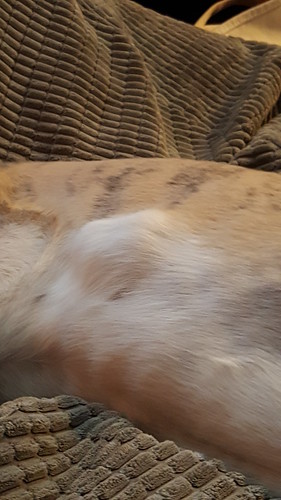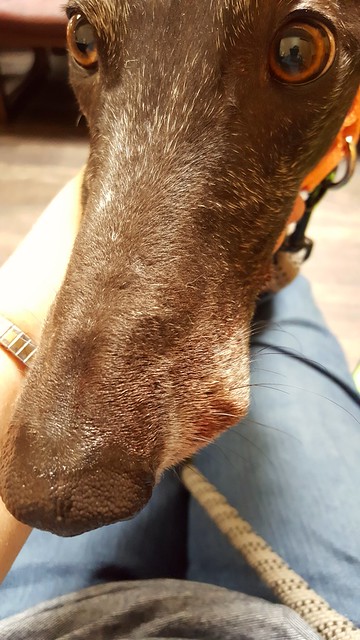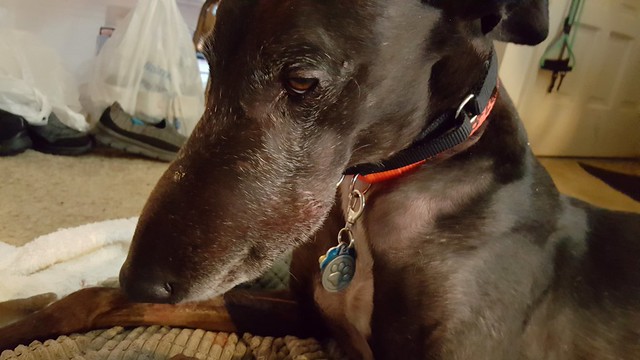-
Posts
2,906 -
Joined
-
Last visited
Content Type
Profiles
Forums
Events
Gallery
Store
Articles
Posts posted by KF_in_Georgia
-
-
I've known of dogs born with only a partial tail. One of them was a superb lure-courser.
Don't let your boy play the sympathy card on you. Keep him muzzled--maybe with a poop guard--so he can't get to his tail to lick or chew. If a bandage disappears suddenly, take him to a vet for x-rays to make sure he hasn't swallowed it. (I know of a case where that happened--and it didn't end well because no one suspected she'd eaten the bandage.) -
-
If you and your vet wind up unable to get a handle on what's going on, consider asking your vet for a referral to a veterinary dermatologist. (Put those two words in the search bar on Google and add your zip code to find the one nearest to you.) I adopted a dog with a bad rash on one leg. My vet and I spent months (and $$$) trying to diagnose and treat it. Took her to the dermatologist and had a handle on it within two weeks, had it cured in a month.
-
Silver's mass was lower right rib cage. It was fixed--felt attached to the rib--and very firm. The vet tried FNA, and what came out didn't register as cancerous or anything else. The lab just said "indeterminate."
She had never had liver problems (and we did lab work on her every year). But the ultrasound specialist looked at her images and said he thought the growth on her heart would rupture within a couple of days. Rather than risk that, we decided to put her to sleep right away--end her discomfort and avoid putting her through a crisis.
I still miss her--a lot. I adored that girl.Good luck with Charlie.
-
It seems I read somewhere that some post-anesthesia hyper-/hypo events may be caused or exacerbated by a lack of potassium. Potassium is a key heart supplement too. I don't know how easy it is to run a level and check.
Actually, the danger is too much potassium post-anesthesia. See here.
-
My Silver had a hard mass on her rib cage. Attempts to get a FNA did not produce anything useful. She was starting to have discomfort just because the mass was awkwardly located, and we decided to remove the mass. Vet did pre-op lab work and her numbers were awful (especially liver). Ultrasound the next day revealed a growth on her heart that had not been present in x-rays three weeks earlier, and we put Silver to sleep. Vet diagnosed hemangiosarcoma.
She didn't seem to feel unwell until that last week, when there was a lot of panting. She was still eating well, but the last day, when we were going in for the ultrasound, she was unable to get into the car without help for the first time--ever.

-
Feed him something at bedtime. Maybe he's getting dinner earlier on the nights he doesn't sleep at home? At any rate, it sounds like empty stomach troubles. Try half a cup of his kibble or a couple of whatever treats he's used to and see if that helps.
-
Usually, xylitol is used to sweeten/flavor liquid meds, especially those that must be given to children. (Gabapentin is useful in preventing seizures.)
Gapabentin capsules contain a powder, and I've never run into xylitol in them, but you could call your pharmacist to check.
When my dogs needed gabapentin, my vet wrote a script that I filled at Walgreen's.
-
Tracker seems to have a split personality: Doesn't eat anything inappropriate--but he eats cat poop.
I'd ask the vet to check for an obstruction. When my Jane was throwing up after meals, she'd swallowed a sock. She was throwing up after meals because there wasn't enough room in her stomach for dinner and the sock, too.
You might try smaller meals, fed more often, and see if he can keep down a smaller amount of food. -
When was Logan's last negative fecal? I agree with Greysmom that you might want to check that. It's possible that his system was handling a parasite infection on its own until the booster shot gave his system something else to deal with--so not diarrhea caused by the vaccine itself but more by coincidentally unfortunate timing.
-
The website says the most common adverse reactions are nausea and diarrhea. There's nothing more specific than that on their website or labels, so it probably doesn't matter either way. My first instinct, though, would be to feed with food in hopes of minimizing stomach upset.
Of course, I don't even give heartworm meds on an empty stomach... -
The problem is that "completely cleared" may not be possible since the hooks can remain dormant in the dog until triggered (maybe by a later illness or other stress?).
My current girl might have dodged hooks, but she was kenneled for years in Florida, so I doubt it. The boy was treated for hooks his first summer with me (2016).
As of January 2018, both dogs had negative fecals. The boy has a tender digestive tract, and anything can throw him into a spell of soft poop, but his output when he has hooks is beyond "soft poop." As long as both dogs are having reasonable output, I'll just test for parasites once a year. I'm not going to assume either dog is clear--just that there's not an active hookworm infestation. Happily, neither dog is a therapy dog, so I don't have to worry about a revival of hooks getting the dog kicked out of a therapy program. (That was a concern with my previous two dogs.) -
From quick Googling: Tortoises can carry oxyurids (pinworms) and ascarids (roundworms) http://www.britishcheloniagroup.org.uk/vetscorner/parasites. I don't see anything that says whether those parasites are cross-species or not.
I don't find any indication that hookworms show up in tortoises.
On the other hand: "In dogs that are cleared of their adult worm infections, the intestinal tract can be repopulated by preexisting, dormant larvae from the somatic tissues that periodically become activated and resume development." That chipper bit of info comes from the Companion Animal Parasite Council: https://www.capcvet.org/guidelines/hookworms/ So Lola could be reinfecting herself.
-
Where are you, and what's the temperature in the area where your grey normally is?
-
1. Muzzle with poop guard http://www.gemgreyhounds.org/GEM-Store/category/muzzle/
2. Child's pajama pants3. Inflatable e-collar (or the original cone), attached to her collar
-
Tigger had been misdiagnosed with a soft tissue injury. But he fell at home, screaming, and couldn't get back up without help. I took him to the ER, and the x-rays showed osteo just above his knee. We euthanized him that night. The ER vet said, "But we can increase the pain meds." Why? He wouldn't get better. He'd already fallen and hurt himself. What would happen if he fell when I wasn't home? Or, if I crated him when I left the house, what would happen if the leg broke while he was in the crate? He had been a therapy dog, but you don't do therapy with a dog on pain meds, so that was over. And having once driven a broken-legged dog (Oreo) to the ER, with her screaming every time I turned a corner and her weight shifted, I knew that wasn't an experience I wanted to repeat or something I wanted to have happen to my boy. After Oreo, I think the fear of a final crisis at home will always be what pushes my decision.
With Silver, who had hemangiosarcoma, not osteo, we euthanized her the same day we got the diagnosis. The doctor doing the ultrasound said he thought she might have only a day or two left. Should I take her home--uncomfortable as she was--and keep her drugged while we waited for a growth to rupture and hemorrhage? The day we got the diagnosis was the first day Silver was unable to get into the car without my help. Silver and I shared a cheeseburger before the vet put her to sleep.
With Sam, it was just old age and kidneys failing. He had arthritis and was taking gabapentin, methocarbamol, and tramadol. But after a day when we'd been harassed by a neighbor's off-leash dog, Sam spent the whole night stressed and panting and didn't sleep. I sat up with him and told him he wouldn't have to spend another night like that. In the morning, we stopped at McDonald's for sausage-egg biscuits on the way to the vet. -
Dogs on soloxine tend to have much softer fur than dogs not on soloxine, and it's the soft-haired dogs that shed the worst, I think. (Or maybe they don't shed more actual hairs, but they shed fluffier hair, so it looks like more.) In that sense, soloxine might influence shedding. My worst-ever shedder, Silver, wasn't on soloxine; but clouds of her very soft fur rose from her body every time she sneezed.
But my second-worst shedder, Sam, was on soloxine--a red-fawn boy with a remarkably soft coat. I could take him outside with a Zoom Groom and pull out an enormous amount of soft fur. Sam was never not shedding.
But if you check greyhound groups on Facebook, at this time of year you see lots of photos of fur that people have brushed out of their hounds. So I think you're just seeing "the perfect shed"--summer shed meeting soloxine soft coat. -
I'd just feed again. Now. And his regular food.
If he threw up that quickly, it wasn't nausea or an upset stomach, it was gravity. (When people throw up, everything has to move vertically--against gravity. When animals throw up, food just moves horizontally, and throwing up is easy.) If he had something caught in his throat and took a bit of water, that would help food come back up. Try to keep him from eating too fast.
-
I've had ailments on dogs that weren't insured or were badly insured.
- Oreo: Broke her leg. Probably osteo, although it didn't show on the xrays. We did orthopedic surgery, but lost her to a blood clot. About $800, uninsured. (I paid out about $800; the surgeon waived his fee.)
- Sam: Just old-age stuff, and not particularly expensive, uninsured.
- Jacey: $4,500 on one weekend (immune system breakdown). I had terrible VPI insurance that reimbursed only $1,000, and I wound up with serious debt. And she died.
- Tigger: Osteosarcoma. Xrays, er visit, euthanasia. About $800 in one week, uninsured.
- Silver: Hemangiosarcoma. Xrays, ultrasound, lots of lab work, euthanasia. About $1000 in her last month, uninsured.
Three of these dogs were only 8 when I lost them, so we never got to the point of deciding whether a 10-year-old should be insured.
-
I have Healthy Paws. My 4-year-old boy, Q, broke an upper canine tooth in his crate--broke the tooth up at the root. And he did it on a Saturday morning, while I was at a meet and greet; by the time I found it, my regular vet was closed. I have CareCredit, so I could put the initial bills on that card and pay them off as soon as I got reimbursed by Healthy Paws.

Healthy Paws doesn't cover the doctor's exam, which I think is silly. The ER bill was $850.43: Emergency fee, office visit, hydromorphone injection, hazardous material disposal fee, propofol IV induction, IV catheter (short term), anesthesia (minor procedure--$216.17), tooth extraction ($164.43), amoxiclav 375mb tabs ($108.08), and tramadol 60 mg tablets.

Feeling sorry for himself the next morning...
The ER recommended dental xrays to ensure they'd gotten all the broken bits of tooth. Not many vets do dental xrays, but SEGA's local vet was willing to anesthetize Q for xrays. $208.90. All the tooth bits were out.
The x-rays were on Wednesday, and we went to our regular vet on Monday. It was time for Q's wellness exam, so we did a fecal and a senior wellness screen, plus the office visit: $217.28. At that time, I was thinking Healthy Paws would pick up the office visit fee ($58.50), but they didn't. They did pay the wellness screen and fecal, which surprised me.
I submitted bills online to Healthy Paws on 9/25. Healthy Paws emailed a confirmation when they got them. On 10/12, they emailed info on what they were going to cover. After the $250 deductible, reimbursement at 80%, they paid $383.14, $167.12, and $110.17 for the three bills: $660.43 total. I had opted for direct deposit, and the money was in my checking account within the week. (I had been paying Healthy Paws $38.40/month for the previous 18 months, so I had paid $691.20 for insurance. So far, this is our only claim with Healthy Paws. I also have my nearly-10-year-old girl insured with them.)
We were very lucky. The tooth didn't cause any sinus damage, and Q didn't have any complications with the meds or with excessive bleeding. We did two weeks of soft food, and the only lasting problems are that he squirts water out of the gap in his mouth every time he drinks, and his tongue falls out that side of his mouth when he sleeps. -
Muzzle with a poop guard to prevent licking.
Or boy's pajama bottoms on backwards (so the fly lets his tail out)...or just feed his tail down the other leg of the pants.
If you want to leave the wound unbandaged but avoid having the wound stick to the pajama bottoms, you can stick a mini-pad to the pajamas in the proper location.
But muzzle with a guard, even if you do the PJs. He could lick through the fabric.
-
An experienced greyhound owner I know has had a diagnosis of LP for her senior agility dog. You can find Jennifer's blog posts here.
-
There isn't really an early warning for osteo...at least, not beyond breaking a bone. Not all osteo patients limp, not all are ouchy. Some break a bone (even when nothing shows on x-rays), others do not. I had an elderly boy (Sam) who yelped--even screamed--when he tried to lie down or stand back up. It turned out to be a problem with his spine, and he was fine when we put him on methocarbamol (aka Robaxin, a muscle relaxer). And I had an 8-year-old boy (Tigger) we thought had a soft-tissue injury from twisting his knee. It turned out to be osteo just above his knee.
For Emmie's sake and your own, don't borrow trouble. Enjoy her, let her play when she wants, and don't anticipate the worst. Take a video of her walking now, so you'll have something for comparison later on. Put a note on your calendar to video her again in three months and compare the results. Meanwhile, unless the vet recommended restricted activity, let her play.And don't keep pressing the sore spot: She'll learn to flinch when people reach for her and then you won't know whether her reactions are because it actually hurts or because she just thinks it's going to hurt.
-
My boy had a canine tooth removed under anesthesia after he broke the tooth up by the root. When I brought him home, he "squeaked" all night. Not a full-throated whine, but just a closed-mouth squeak. And this is my silent dog: the one that never barks or whines.
Perfectly normal after anesthesia.



Question Re: Advantage Multi
in Health and Medical discussion
Posted
It dissipates, and a couple of hours after application you should be fine to take a dry paper towel and blot off the excess oil. (According to the label, the dog can have a bath 90 minutes after application and still be protected against heartworms. I'm not sure I'd push it that far...)
In the interim, I used to use bandannas (for the first couple of days). They reminded me where not to put my hand and gave me something vaguely collar-like to grab if I needed a "handle."
I didn't like the smell of the Advantage Multi--it was worse than Frontline. But I had a dog who wasn't tolerating the flavoring added to heartworm meds, and I welcomed a topical alternative. These days, Advantage Multi is supposed to be "da bomb" in the battle against hookworms.